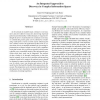Free Online Productivity Tools
i2Speak
i2Symbol
i2OCR
iTex2Img
iWeb2Print
iWeb2Shot
i2Type
iPdf2Split
iPdf2Merge
i2Bopomofo
i2Arabic
i2Style
i2Image
i2PDF
iLatex2Rtf
Sci2ools
WEBI
2004
Springer
2004
Springer
An Integrated Approach to Discovery in Complex Information Spaces
As the amount of available data continues to increase, more and more effective means for discovering important patterns and relationships within that data are required. Although the power of automated tools continues to increase, we contend that greater gains can be achieved by coordinating results from a variety of tools and by enhancing the user’s ability to direct the application of these tools. A system which can rely on multiple modalities for processing information has a distinct benefit in terms of user-confidence in the final results. We set forth an approach which permits a flexible, user-controllable model of the information space within which basic tools can be integrated. The analysis of data, whether it be through visualization or data mining, for example, is an exercise in problem-solving and any computer-based tool to support the analysis process should be designed to support problem-solving activities. The process by which a user can develop and interact with thi...
| Added | 02 Jul 2010 |
| Updated | 02 Jul 2010 |
| Type | Conference |
| Year | 2004 |
| Where | WEBI |
| Authors | Daryl H. Hepting, Cory J. Butz |
Comments (0)

